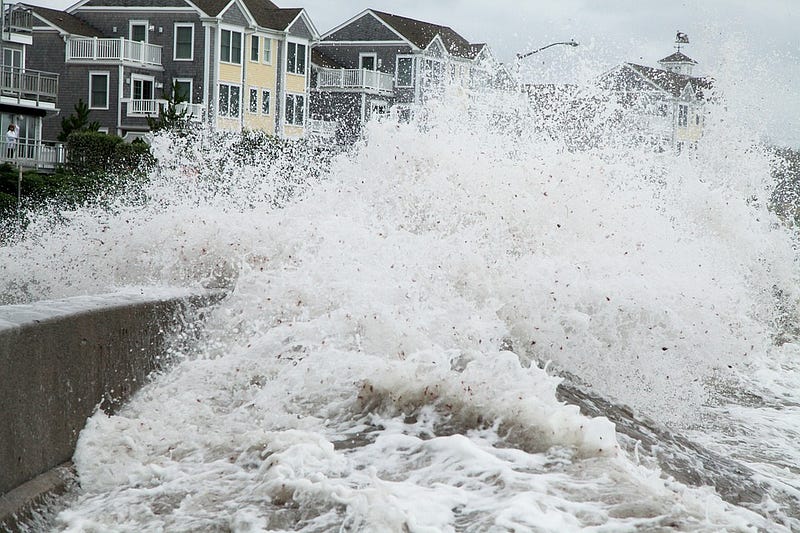A new level of planning: how cities are adapting to rising sea level
By Kelly Thomas, Journalism, 2023

In the wake of sea level rise, which threatens to inundate hundreds of cities worldwide in the coming years, coastal cities have begun to adapt their infrastructure. Many at-risk cities have issued climate adaptation reports that detail their plans to prepare for the coming threat, with some already experimenting with innovative infrastructure ideas.
According to NASA, the global sea level is currently rising at a rate of 3.3 mm, or approximately 0.13 inches, per year. This rise can be attributed to two main factors: thermal expansion and melting ice sheets and glaciers. Thermal expansion occurs as the earth’s rising temperature causes water to heat and expand, pushing sea level upward. Melting ice is also a result of increasing mean global temperature. With a higher sea level, storms become even more dangerous. “Storm surge,” an increased sea level caused by storms, in combination with a standard sea level that is higher than in the past, creates elevated risks of coastal flooding.
With a higher sea level, storms become even more dangerous.
Creative strategies have sprung up to fight against current and future flooding. Coastal cities are utilizing green or gray infrastructure, or a combination of the two. Gray infrastructure traditionally takes the form of concrete barriers or seawalls, in addition to piped drainage and water treatment systems. These structures block cities from flood water, diverting it elsewhere. Coastal cities have typically employed this method of stormwater management in the past. As they plan for the future, many cities are looking toward green infrastructure. This method entails the construction of natural habitats along the coast like mangroves, reefs, and wetlands that buffer storm surge and erosion, as well as urban spaces such as parks and green roofs that are permeable and capture runoff during storms. While gray infrastructure is impervious and prevents the absorption of storm water, green infrastructure is centered around absorbing, filtering, and storing water.
The city of Rotterdam in the Netherlands, divided by a river and located near the coast, aims to be “climate proof” by 2025. Rotterdam’s plan is a melding of multiple strategies; its initiatives include making adaptations to their existing gray infrastructure like storm surge barriers and dikes, as well as creating more green space in the form of gardens and public parks. Additionally, the city plans to create public spaces called “water squares” that serve as rainwater storage pools in the event of flooding. Rotterdam hopes to implement social value into these adaptations, such as through their proposed “tidal park” that not only buffers storm surge, but also provides recreational space for citizens and increases overall biodiversity.
The city of Rotterdam in the Netherlands, divided by a river and located near the coast, aims to be “climate proof” by 2025.
Boston’s climate response is still in the works, though the city has released a comprehensive plan of how it is seeking to address the issue. Its climate vulnerability assessment report states that in the future, flooding from high tides could result in monthly flooding for “low-lying neighborhoods along the waterfront.” Boston has drafted a slew of initiatives to address the problem, some of which the city has already started implementing, such as updating local flood maps and creating designs for green infrastructure. A unique aspect of Boston’s plan is its initiative to provide living wages to workers involved in their projects and to “prioritize use of minority- and women-owned businesses,” according to the report. The plan features eight “focus areas,” which are neighborhoods that are particularly vulnerable to flooding risks and most imminently require resources and action.
The city of Miami, Florida, similarly vulnerable in its coastal location, has also developed a multi-faceted approach to the problem. Miami has already been installing pump stations that drain water from urban areas, along with tidal control valves that prevent water from surging from pipes onto the streets during high tide. The city also plans to use green infrastructure and is currently restoring living shorelines along the coast.
Boston has drafted a slew of initiatives to address the problem, some of which the city has already started implementing, such as updating local flood maps and creating designs for green infrastructure.
While some at-risk cities have been proactive in putting forth organized efforts in how they plan to adapt to climate change’s effects ─ specifically sea level rise ─ not all have done so. Additionally, some places, particularly island nations, face such a dire risk that they may have no choice but to leave their land and migrate elsewhere. Indonesia, for example, has already announced plans to relocate its capital from Jakarta to the island of Borneo, motivated by regular and damaging flooding that will continue to worsen. However coastal cities decide to adapt, it is inevitable that they do so; the development and execution of innovative strategies, including those that utilize green infrastructure, will be crucial in the coming years.
